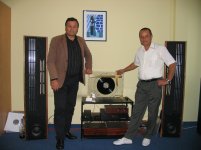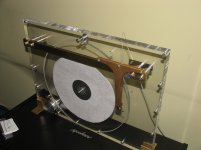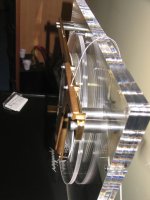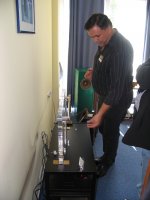Here are some pictures of the turntable presented for the first time on the Ljubljana hifi show.
The idea to built it vertical was born from search how to make the tonearm without counterweight and antiskating and here are the results.
The sound of this turntable is bigger,deeper,more dynamic,with better timing and colors of instruments and so on.One of the visitors,recording engineer by the profession and owner of the ET tangential tonearm stated after the test with his own LPs,that this one is better.
The designer Bruno Puhar on the left has also designed and produced my turntable and tonearm many years ago.
The idea to built it vertical was born from search how to make the tonearm without counterweight and antiskating and here are the results.
The sound of this turntable is bigger,deeper,more dynamic,with better timing and colors of instruments and so on.One of the visitors,recording engineer by the profession and owner of the ET tangential tonearm stated after the test with his own LPs,that this one is better.
The designer Bruno Puhar on the left has also designed and produced my turntable and tonearm many years ago.
Attachments
Bang & Olufsen used to have a vertical TT (IMHO for futuristic aesthetic design). How is the cartridge pushed to the LP, by a spring? Also how is the LP pushed to the platter? Interesting design, but not very user friendly. Gravity is not bad, it has only one disadvantage: if affects also dust particles...
This turntable is prototype and here it do not have a cover for arm support,but it will be made.The dust can be obstructive for 2 balls (4-5mm in diameter) on which the arm travel.It will be possible to mount 1 arm on each side,with pick up turned upward on the left arm.
In this case the arm is designed for Denon 103R,so the gravity make the press.Also it is possible to regulate the press with inclination,but this is not really the right way to do it.
It will be enough to mount a little counterweight for regulation,or optional,but not yet enveloped,with electro-magnet.
The LP is pushed to the platter with magnetic clamp.
The VTA could be adjusted with the screw behind the spindle,also during the play back.When you turn the screw,you move the spindle together with platter.
In this case the arm is designed for Denon 103R,so the gravity make the press.Also it is possible to regulate the press with inclination,but this is not really the right way to do it.
It will be enough to mount a little counterweight for regulation,or optional,but not yet enveloped,with electro-magnet.
The LP is pushed to the platter with magnetic clamp.
The VTA could be adjusted with the screw behind the spindle,also during the play back.When you turn the screw,you move the spindle together with platter.
Attachments
I would recommend not to use electromagnets in the vicinity of ultra-sensitive pickups working on the electromagnetic principle... Even a static magnetic field may affect the pickup, having also a strong permanent magnet inside...
The arm travels just on that ball and track setup? Wouldn't the friction of this be fairly high, such as why air bearings are used in some "conventional" linear trackers? Or would that the tracking force is applied by gravity / vertical balance and not by the extra weight of a counterweight reduce the moving mass (of the arm) enough that this isn't an issue with good quality bearings?
Very clever, all in all.
It would probably be a good idea to just a screw-on clamp.
Very clever, all in all.
Add to this the fact that it wouldn't really be a static field what with the magnet turning, though I don't think this would be a significant difference.I would recommend not to use electromagnets in the vicinity of ultra-sensitive pickups working on the electromagnetic principle... Even a static magnetic field may affect the pickup, having also a strong permanent magnet inside...
It would probably be a good idea to just a screw-on clamp.
I like vertical turntables, but have never owned one.
Mitsubishi used to have vertical turntables (LT series) using motors and servos to move the arm and springs (I think) for tracking force. They also had a compact stereo system called the X-10 (I think). I always thought one of these as a bedroom system would be very cool. Similar to the old KLH Model 20 Garrard turntable/KLH tuner amp combination units, but vertical. AR had a similar one. Someone here on diyaudio.com has one, intending to refurbish it (I think it is an AR turntable/receiver). Some of the Duals used a spring for tracking force, and an old demo used to have the salesman lift the back of the turntable upward towards a vertical orientation.
This table would benefit from some sort of clamp, but as stated, perhaps something not magnetic (although perhaps the simplest method). If a magnetic clamp is the only option, I would suggest shielding the magnet with mu metal (B field blocking). I would stay away from using any magnet to provide tracking force. A hung weight could achieve the force required easily enough.
Marine Boat, there are some excellent linear trackers using roller bearings (sealed types), that could ride in a channel, a knife edge or even on a high tension wire. I like the simplicity of the Opus3 (Rauna) arm.
Mitsubishi used to have vertical turntables (LT series) using motors and servos to move the arm and springs (I think) for tracking force. They also had a compact stereo system called the X-10 (I think). I always thought one of these as a bedroom system would be very cool. Similar to the old KLH Model 20 Garrard turntable/KLH tuner amp combination units, but vertical. AR had a similar one. Someone here on diyaudio.com has one, intending to refurbish it (I think it is an AR turntable/receiver). Some of the Duals used a spring for tracking force, and an old demo used to have the salesman lift the back of the turntable upward towards a vertical orientation.
This table would benefit from some sort of clamp, but as stated, perhaps something not magnetic (although perhaps the simplest method). If a magnetic clamp is the only option, I would suggest shielding the magnet with mu metal (B field blocking). I would stay away from using any magnet to provide tracking force. A hung weight could achieve the force required easily enough.
Marine Boat, there are some excellent linear trackers using roller bearings (sealed types), that could ride in a channel, a knife edge or even on a high tension wire. I like the simplicity of the Opus3 (Rauna) arm.
Seeburg jukeboxs played vertical. The pivot point was at the bottom too. Force was provided by springs. Although not an LP player it was designed that way to maximize the amount of records it could access in a rack.


Last edited:
One of the visitors,recording engineer by the profession and owner of the ET tangential tonearm stated after the test with his own LPs,that this one is better.
Better? Nevermind the system/room and everything else was different?
But is it better than an upside down turntable?
Btw, how does the main bearing work?
The benefit for turntable is the 40cm platter,that have bigger inertia than 3kg 30cm platter.This is the reason for higher dynamic and better timing,even better than on my turntable which is described in THREE MOTOR TURNTABLE topic.
Only vertical arm can be made without counterweight and antiskating and this is the bigger benefit to be vertical.
In the front side,behind the platter the spindle is laying on two points below it,on the back it is fixed opposite,from the top.This two pairs of supports are interchangeable.Please,do not ask me for the materials.
Some designs should be left to other inventors.
Only vertical arm can be made without counterweight and antiskating and this is the bigger benefit to be vertical.
In the front side,behind the platter the spindle is laying on two points below it,on the back it is fixed opposite,from the top.This two pairs of supports are interchangeable.Please,do not ask me for the materials.
Some designs should be left to other inventors.
It is pretty. I always liked the vertical B&O CD changers but never could justify one.
Yes, you can make a lower-mass lower-inertia arm with some tracking benefits when the design eliminates any counterweight. In a conventional pivoting arm the counterweight is near the pivot and barely moves, but it a linear arm the counterweight moves the entire distance the cartridge moves, which makes its mass significant toward inetia. But that doesn't look like a very low-mass arm anyway.
Any straight-tracking linear type can do away with anti-skate correction.
The demo Dual used to do was to show that a dynamically-balanced arm with tracking force and ant-skate applies via springs at the pivot meant that you didn't have to level the turntable, making it especially suitable for a portable or disappearing turntable (if the counterweight stays in place). This vertical table looks like levelling will be very critical instead.
I very much like that the linear bearing overlaps the platter diameter. Good idea. Why not take it a step farther and make a much shorter arm, as long as you can slip the record under? Applies the force vector more in line with the desired motion direction.
Yes, you can make a lower-mass lower-inertia arm with some tracking benefits when the design eliminates any counterweight. In a conventional pivoting arm the counterweight is near the pivot and barely moves, but it a linear arm the counterweight moves the entire distance the cartridge moves, which makes its mass significant toward inetia. But that doesn't look like a very low-mass arm anyway.
Any straight-tracking linear type can do away with anti-skate correction.
The demo Dual used to do was to show that a dynamically-balanced arm with tracking force and ant-skate applies via springs at the pivot meant that you didn't have to level the turntable, making it especially suitable for a portable or disappearing turntable (if the counterweight stays in place). This vertical table looks like levelling will be very critical instead.
I very much like that the linear bearing overlaps the platter diameter. Good idea. Why not take it a step farther and make a much shorter arm, as long as you can slip the record under? Applies the force vector more in line with the desired motion direction.
- Status
- Not open for further replies.
- Home
- Source & Line
- Analogue Source
- Vertical turntable



